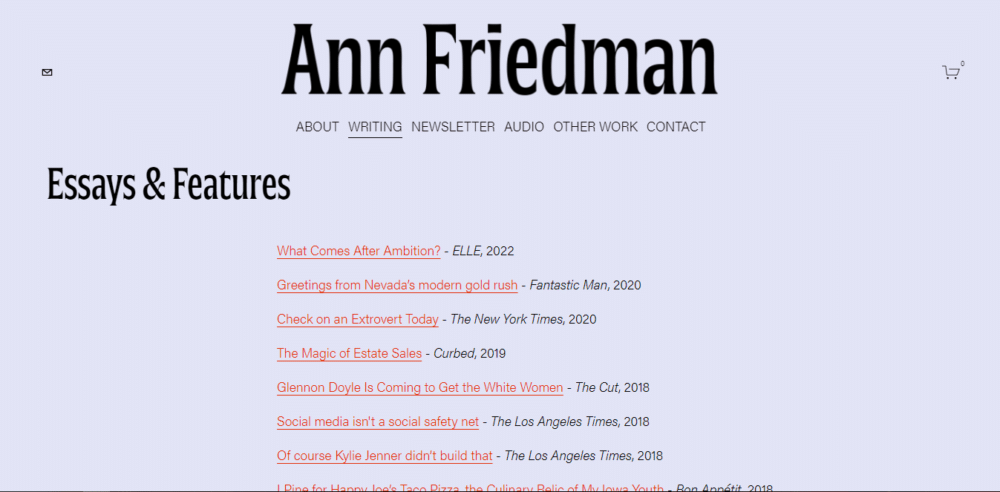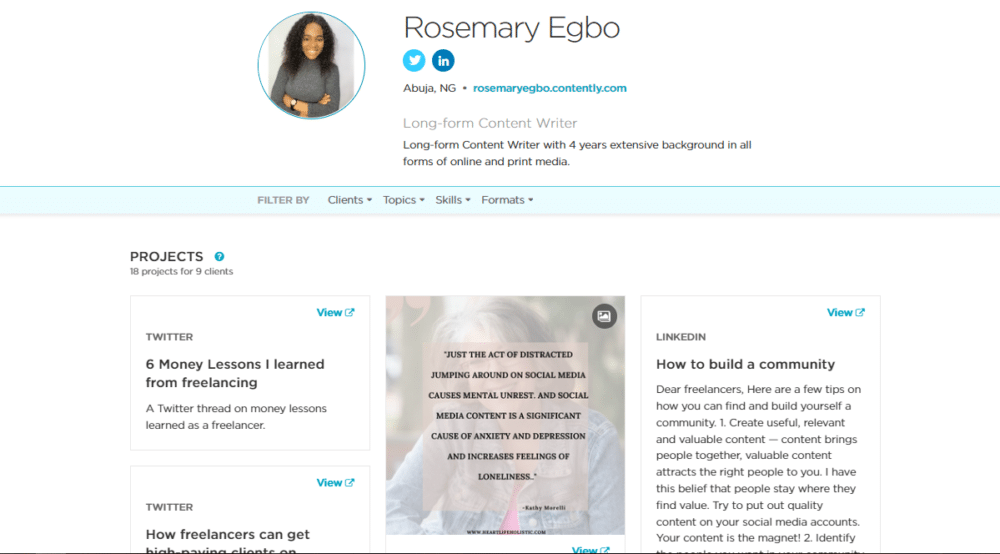With the influx of new freelancer writers and writing platforms, standing out is crucial to landing your next writing task. And what better way to do that than showcasing your writing portfolio?
For instance, the United States Bureau of Labor and Statistics (BLS) reported an over 11 percent increase in writers in 2021.
And there are indications these numbers will increase with continued support for digital marketing, self-publishing, etc.
While this may signal more competition for writers, there are still not enough writers for the available writing jobs.
Money Note: If an extra $1K–$5K/month would change your 2026 goals (debt, savings, travel, freedom), you’ll want to catch this: free live workshop from a freelancer who’s earned $4M+ online. No fluff. No gimmicks. A real roadmap. 👉 Watch the training or save your seat here »
For one, there are over 31 million small businesses in the US that need writers. Add that to the numbers of bigger companies and corporations, plus online writing opportunities, and you’ll discover the demand for writers is ever-increasing.
So, if you’re not getting good-paying writing jobs yet, it’s time you create a writing portfolio or improve the one you already have.
Below, you’ll understand what writing portfolios are and the steps for creating an effective one, with examples to help you get going immediately.
Alright, let’s dive in.
What is a writing portfolio?
A writing portfolio combines a writer’s best works, or at least the selected works, in a single place to grant easy access to potential and current employers, followers, students, readers, or anyone who might request it.
Your freelance writing portfolio saves you from having to compile your work every time someone asks you for them or inquires about your skills. It could contain articles, blog posts, sample write-ups, press releases, article submissions, and any other work that displays your writing expertise.
A portfolio is a crucial tool that comes in handy when marketing your skills or services. It is usually one of the first potential employer’s requests. Any client wants to ensure you can do their tasks, and one of the best methods for checking is looking at the ones you’ve done for others.
Therefore, a portfolio can open doors and sell your skills effectively when done right. It also shows the clients you’ve worked with before. It would be a good idea to add that post you did for a celebrity or the one that’s published on a popular website.
Writing portfolios are often contained on a personal blog or website. Portfolio hosting websites are also quite common for anyone who doesn’t own a blog. There are other methods which we’ll get into pretty soon.
However, your portfolio doesn’t have to house all the works you’ve ever done. That is why a carefully hand-picked selection of the best works will improve your chances in a particular niche.
Why every freelance writer needs a writing portfolio
Now that you know what a portfolio is, let’s look at the benefits of getting one for yourself.
1. To get more jobs
The ultimate aim of a freelance writing portfolio is to help you get more jobs. Portfolios are a normal requirement for getting jobs, and compiling your writing samples beforehand will put you in a better position to get one.
That’s because it shows you have experience and the necessary expertise to get a job done. Next time you go job-hunting, you can rest assured, knowing you have a portfolio to call upon immediately.
2. To show your writing skills
One of the reasons your portfolio helps you get jobs is that it showcases your skills. If you’ve picked up a skill or two from freelance writing courses and applied it to your work, potential clients can easily notice from the portfolio, especially if it’s what they’re looking for.
Irrespective of the reasons, an online writing portfolio lets anyone know which types of writing you’re comfortable with or niches you have experience in. It also puts your versatility on display, which will be essential for clients that need writers to work on multiple niches.
3. To show your interests and likes
Many writers have a particular niche they love working in. Some are interested in this niche and actively search for only related jobs. The portfolio can help to communicate this in an instant.
Directing a potential employer to a portfolio with your interests makes it clear what you love working on, and if it’s related to what they want, chances are high that they would love to hire you. To avoid appearing like a one-trick pony, vary the styles in your samples, even if the niches are the same.
4. To market a product or service
Creating an online writing portfolio also increases your chances of marketing a product successfully. For example, you’ve written a book or have a writing course you’re trying to promote. A popular writing portfolio will be quite handy in promoting the service or product to followers.
Since you can include a biography in your writing portfolio, it also aids with personal branding and promotion for anything you have on offer.
5. To monitor your accomplishments as a freelance writer
Writers work on so many tasks that it becomes impossible to track every one of them. Updating your writing portfolio helps you keep track of the most important ones while keeping them close for any urgent need.

11 Steps to create your writing portfolio
Creating your online writing portfolio is quite straightforward if you pay attention to all the important elements. Below are the steps you need to take from start to finish.
1. Set clear objectives from the start
When many people decide they need a writing portfolio, they start by investing in a domain name only to realize a while later they don’t know what to include in their portfolio page.
Instead, start by outlining the immediate and long-term goals you want to achieve.
For instance, an online portfolio that’s supposed to help you market your book may be slightly different from one that you hope to use for a quick job search. Likewise, the copywriting portfolio will also contain different content from the one you want to use for journalism gigs.
That means you must ask yourself some important questions to help you clarify your online writing portfolio objectives.
- Are you applying for jobs on a freelance website?
- Are you trying to grow your freelance writing business?
- Do you intend to use the portfolio for academic purposes?
- Do you want to score a role on the local news journalism team?
- Would you love to get noticed by that renowned author you wish to collaborate with?
Setting objectives helps you remain specific and focused. Write it down somewhere so you can use it to confirm if you’re still on track throughout the process. While this may take a little bit, it’s well worth every second you put into it.
2. Specify a writing niche
Something else you should do before jumping in is to specify the niche you intend to concentrate on. You may agree that including as many niches as possible in your freelance writer portfolio shows versatility, but it also depicts a lack of focus.
Showing potential clients that you’ve worked in many niches may send the message that you’ve tried your hands on it all but can’t offer much in a particular niche.
Here’s a scenario. Consider receiving two portfolios for your B2B content marketing task. One has written ten B2B marketing blog posts, while the other has done twenty on a wide range of topics, from automobiles to Chinese recipes.
You’d prefer the first one because they’ve shown experience tightly related to your niche. The latter has only shown you quantity, but nothing suggests they can handle your job.
So, take out the guesswork for potential clients by focusing on a niche.
Another thing that helps with setting objectives is looking at the jobs you’ve done before. If most of your jobs fall into the real estate niche, for instance, you will find it easier to set up a related portfolio as well as secure real estate gigs.
Note that some portfolios could combine multiple niches. This works if done with care and with deliberation. The key is to segment each item carefully and not mix unrelated items in a section. It also helps not to include too many niches.

3. Decide where to host your portfolio
Now that we’ve gotten the deliberations out of the way, let’s get to the fun parts. Actually, you still need to deliberate on this. Where do you host your online writing portfolio?
There are a couple of options, but we’d classify them into three — your own writer website, portfolio websites, or storage websites.
Your website
Hosting your portfolio on your website is the best option. If you already have a freelance writer website, most of the work is done because you just have to create a new page and dedicate it to the tasks you’ve handled.
Creating one is a good idea if you don’t have a website. First, get a domain name through providers like Namecheap or GoDaddy, then get hosting through Bluehost, WP Engine, or similar. You should use your name if it’s still available or add a word to it if it’s not.
Portfolio sites
Perhaps you’re not ready to get a website. Another option that works well is using one of the best portfolio sites like Medium, LinkedIn, Clippings.me, Contently, Journo Portfolio, Quiet.ly, Muck Rack, etc.
These sites let you upload and publish content, and everything you’ve worked on can be accessed from a single place. Each one also has its own style. While some let you arrange items like a personal website, others only offer self-publishing opportunities.
Storage sites
The last option is to use cloud storage like Google Drive. This option lets you upload files with a link you can share with anyone requesting your portfolio.
Whichever one you choose from these options, you’d have access to most of what you need for your writing portfolio.
4. Design your writing portfolio carefully
Portfolio design is another interesting aspect of setting up your portfolio but be careful as overdoing this part can mar your hard work. Here are some useful tips on portfolio design:
- If you can get the services of a website designer, a UI/UX designer, or a product designer, go for it. Nothing can beat the work of a professional.
- Keep it simple as you don’t want to make it difficult for potential clients to get around your samples. And this is certainly not the time to try out those basic graphic design skills you’ve picked up along the way.
- Make sure the font is professional and readable. No Joker, Comic Sans, or Monotype Corsiva.
- Ensure there are enough spaces between lines and use a legible font size.
- Stay away from using too many colors. Two colors are fine, but ensure they’re professional with the right amount of contrast to aid readability. That is, place a dark color on a light background and a light color on a dark background.
- Consider the arrangement of items on your portfolio. They can either be text-based or image-based. Texts usually work, but images can give your portfolio more life.
- Make sure to use images related to the content. Use high-quality and royalty-free images or create them yourself.
- Finally, consider both mobile and tablet users. Again, this may be down to your hosting website, so you should check it before hosting.
5. Review existing writing samples
Now, it’s time to open your writing folder to pick samples contributing to your objective. Go for your best works – they should be professional, in-depth, and properly structured. Put yourself in the potential client’s shoes to see which piece would appeal better to them.
But wait!
Due to copyright issues, selecting samples from the tasks you’ve carried out can be tricky. You may not be able to add most of the jobs you worked on as a freelancer because that’s what being a freelancer is — you accept to relinquish the rights to a piece you get paid for.
We have a whole guide dedicated to discussions on adding agency or in-house jobs to your portfolio. Essentially, you can only include pieces you have rights to. Not the ones you’ve done as part of an agency or as a freelancer. If you’re not sure, ask your client or boss if you can use them.
Since the aim is to give potential employers an idea of what you’re capable of, you don’t have to worry about work you don’t have rights to. Instead, you can use the options below.
6. Write and add guest posts
Picking from previous jobs is obviously for those with experience, but you can still be a freelancer without experience. You can create your samples by writing guest posts for notable websites.
Guest posts also give you visibility and credibility as a published freelance writer. Do a quick search on Google, and you’ll find several options you can choose from. If you need help crafting any topic, consider the aid of AI writing tools.
7. Write for non-profit organizations
Non-profit organizations also present wonderful opportunities to get content you can add to a portfolio. And there are also numerous organizations out there seeking volunteer writers. Although you will be offering pro bono services, these experiences enrich you and your writing portfolio.
8. Include your biography
Creating a portfolio doesn’t end with adding relevant samples. You can include a short biography, overview, or a writer’s business card. This is an opportunity to give clients a little more information that you feel will boost your chances of getting hired.
It is common for people to add their name, job title, experience, awards, achievements as a writer, social media links, etc. You may also include details about your skills, work, or tools you use. Just don’t bore them with a long write-up.
9. Add client testimonials
This often gets overlooked, but it’s quite essential. If you’ve worked with some employers before, request testimonials from them and add a few to your writing portfolio. It will increase the value and show clients how good you are at your work.
10. Add a clear call-to-action (CTA)
The main objective of a writing portfolio is to prompt clients to hire you. No matter how impressive the portfolio is, adding a CTA can give an extra push. Perhaps they cannot quickly process all they just read or are considering another prospect, seeing a big “Contact Me” or “Work With Me” button that goes to your email address can help their decision-making.
11. Update your portfolio regularly
Your portfolio is live, but it’s important to keep things ticking. So update it with newer write-ups regularly as you create more content. It will help you grow easily while showing clients you’re still active.
Writing portfolio examples to inspire you
These are examples you can use to get a head start.
Jennifer Fernandez
Jennifer Fernandez is a freelance writer and editor whose writing interests include design, travel, and lifestyle. The portfolio website has three pages dedicated to each interest and another as the about page. This design is straightforward and consists of content titles and images.
Ann Friedman
Journalist and author Ann Friedman’s portfolio website is another beautiful example. But unlike Jennifer’s, there are no images. Instead, Ann lists each publication with links to the pages alongside the date and publishing organization.
Francesca Nicasio
Francesca Nicasio’s portfolio has maximized all the necessary components mentioned above. First, the homepage highlights some of her achievements and those she’s worked with, plus testimonials. Then, the copywriter’s portfolio features screenshots and links to some of her works.
Rosemary Egbo
This portfolio from Rosemary Egbo, a content writer, was created using Contently’s portfolio hosting service. It has a professional job title, social media links, and links to her samples on Contently and other websites.
Caitlin Reid
Caitlin Reid’s portfolio was created with Clippings.me, another portfolio hosting website. I love this one because it combines so many things neatly. It has the name, job title, location, social media links, and a brief background at the top. It’s the same level of conciseness on the portfolio items that features a title, image, date, and link.
The writing industry is getting increasingly competitive…
And you need everything you can get to boost your chances. A writing portfolio should be at the top of the list for anyone serious about their writing.
As highlighted above, portfolios serve a couple of purposes and come with several advantages. It can seem challenging to begin, but by following the steps highlighted and following a planned schedule, it should be a breeze.
Remember to keep an eye on your objectives throughout the process. They will help you focus on what matters and keep you going. Also, remember to keep things simple, and you’re on your way to building a portfolio that stands out.
Keep the conversation going...
Over 10,000 of us are having daily conversations over in our free Facebook group and we'd love to see you there. Join us!







